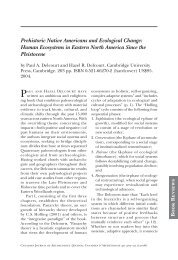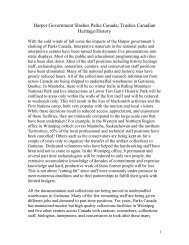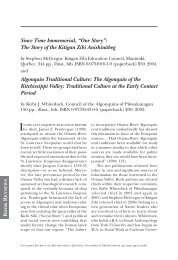(1): numéro de l'atelier / session number Abel, Tim - Canadian ...
(1): numéro de l'atelier / session number Abel, Tim - Canadian ...
(1): numéro de l'atelier / session number Abel, Tim - Canadian ...
- No tags were found...
Create successful ePaper yourself
Turn your PDF publications into a flip-book with our unique Google optimized e-Paper software.
as Metepenagiag Heritage Park. On most of these sites, calcined sturgeon scutes andspines (many i<strong>de</strong>ntified as Acipenser oxyrinchus) dominate faunal assemblages. Thispaper will explore the distribution of sturgeon remains in these sites, and presentpreliminary NSERC-supported research on their implication for our un<strong>de</strong>rstanding of therelationship among the ancient Mi'kmaq of Metepenagiag, the Miramichi River, andsturgeon.Blouin, Yanik, Consultant Travaux archéologiques au Champ-<strong>de</strong>-Mars : analyse etcomparaison <strong>de</strong>s mo<strong>de</strong>s <strong>de</strong> construction chez <strong>de</strong>ux équipes <strong>de</strong> maçons du XVIIIe siècle(27) En 1717, Chaussegros <strong>de</strong> Léry amorce la construction d’une enceinte bastionnéeprotégeant la ville <strong>de</strong> Montréal. Le projet n’est achevé qu’en 1744 et il aura requis laparticipation <strong>de</strong> plus <strong>de</strong> 230 artisans et journaliers, sans compter l’ai<strong>de</strong> apportée par lessoldats en poste dans la ville. Aujourd’hui, les vestiges mis en valeur au Champ-<strong>de</strong>-Marsconstituent l’unique exemple d’un front complet <strong>de</strong> cette ancienne fortification. Lestravaux <strong>de</strong> restauration qui ont pris place en 2010 ont donné l’occasion <strong>de</strong> procé<strong>de</strong>r à unrelevé exhaustif <strong>de</strong>s parements <strong>de</strong> l’escape et <strong>de</strong> la contrescarpe. Leur analyse permet <strong>de</strong>reconstituer les gestes <strong>de</strong> <strong>de</strong>ux équipes différentes <strong>de</strong> maçons, <strong>de</strong> même qu’elle soulève <strong>de</strong>nouvelles avenues pour l’enregistrement et la <strong>de</strong>scription <strong>de</strong>s vestiges archéologiques.Un<strong>de</strong>r Chaussegros <strong>de</strong> Léry, Montreal’s fortification was built between 1717 and 1744.Today, Champ-<strong>de</strong>-Mars remains are the last example of a complete front of this oldfortification. In 2010, an archaeological survey allows an exhaustive drawing of the walls.Their analysis shows differences between two mason teams. Also, the conclusion bringssome new ways in field archaeology.Bonneau A<strong>de</strong>lphine (Laboratoire d’archéologie, Université du Québec à Chicoutimiand Laboratoire d’archéologie, Université Laval), Jean-François Moreau(Laboratoire d’archéologie, Université du Québec à Chicoutimi), Réginald Auger(Laboratoire d’archéologie, Université Laval), Bertrand Emard (Hydro-Québec)Analytical studies of European Tra<strong>de</strong> Glass Beads in Quebec: what instrument for whatkind of results? (21) Chemical analysis on tra<strong>de</strong> glass beads in Quebec were performedsince the 1990’s by Ron Hancock and Jean-François Moreau using Neutron ActivationAnalysis (NAA) (Hancock et al. 1996, Moreau et Hancock 2010). This work results on ahuge database of tra<strong>de</strong> glass beads composition that can provi<strong>de</strong> an estimate dating for thebeads by comparison of the chemical composition. However, new questions are asked bythe archaeologists: how were these beads ma<strong>de</strong>? Is it possible to make sub-groups in thedating groups in or<strong>de</strong>r to follow the penetration of beads from their coastal point of arrivalinto the continent? In literature, two techniques are more and more <strong>de</strong>veloped: Ramanspectroscopy, which gave us the opportunity to find the “shape” of the opacifiers in theglass, to i<strong>de</strong>ntify the type of glass and to make different groups of beads because of theirglass type; and LA-ICP-MS, gave us the total composition of the glass with the analysisof 38 chemical elements and thus makes possible to <strong>de</strong>fined sub-groups of beads whichcorrespond with archaeological evi<strong>de</strong>nce on the site.Bouchard-Perron, Julie-Anne, Émilie Young-Vigneault et Nadia Ardila (G.A.I.A.Inc.) Se doter d’un toit et d’une pitance au 17 e siècle: Résultats <strong>de</strong>s analysesenvironnementales sur le site du Parc <strong>de</strong>s Braves à Québec (30) Au cours <strong>de</strong> la fouille dusite du Parc <strong>de</strong>s Braves par la Commission <strong>de</strong>s Champs <strong>de</strong> Bataille Nationaux à l’été








